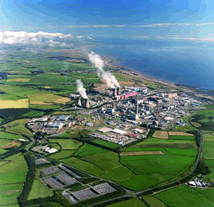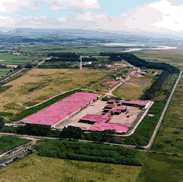Managing Radioactive Waste - your views matter
Radioactive waste in the UK |
Info Card 1: Front |
|
Radioactive waste has been produced in the UK since the 1940s, mainly from developing and using nuclear power. The waste is hazardous to human health and some will continue to be hazardous for thousands of years. |
Radioactive waste is sometimes packaged in concrete and steel. Image: BNFL |
The radiation that comes from radioactive waste could cause cancer or birth defects if the dose is high enough. We need to find the best way of dealing with the waste to protect humans and the environment. |
Sellafield - where much of the UK's radioactive waste is produced and
|
There are currently around 80,000 cubic metres of solid radioactive waste in storage. Compared with the 40 million cubic metres of household waste we produce every year it is a tiny amount. |
The radioactive waste we have produced so far is being processed and stored until we decide how to manage it in the long term. Many nuclear power stations will be carefully dismantled over the coming decades, and this means that the amount of radioactive waste that needs to be managed will increase. |
Although the amount of radioactive waste we produce is relatively small, radioactive waste must be dealt with particularly carefully because of its potential hazards to human health. |
CoRWM has been asked by Government to make its recommendations on the long- term management of radioactive waste by July 2006. |
|
The story so far |
Info Card 1: Back |
|
At the moment most types of radioactive waste are stored where they were produced (the map shows where). Low level waste is transported to a disposal facility near Drigg in Cumbria.
Decisions about how to manage radioactive waste in the short term, need to be made with the knowledge of what we will do with the wastes in the long term. This is why we need to decide on long-term policy soon. |
 |
So far CoRWM has considered a list of 15 options for dealing with radioactive waste, and through consulting with specialists and the public, has narrowed this down to three options that each deal with all the types of radioactive material that CoRWM has to consider. These three options are described on info cards 4, 5 and 6. |
CoRWM is also deciding whether to further assess a near surface disposal option that might be used for some short-lived or less hazardous radioactive wastes. Because CoRWM has not yet reached a decision, this option has not been included in this discussion guide. However Questions 1 to 6 in this guide are all relevant to the near surface disposal option, and your responses to them would be used in any detailed assessment of it. You can find out about all the options and why some were not short-listed on the CoRWM website, www.corwm.org |
||
Low level waste is disposed of at a facility near Drigg in Cumbria. Image: BNFL |
Map showing location of UK radioactive waste |
|


